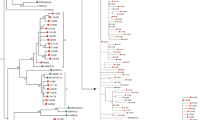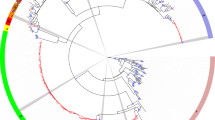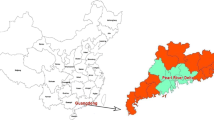Abstract
Few reports are available on HCV molecular epidemiology among IDUs in Eastern Europe, and none in Montenegro. The aim of this study was to investigate the HCV genotype distribution in Montenegro among IDUs and to perform Bayesian and evolutionary analysis of the most prevalent HCV genotype circulating in this population. Sixty-four HCV-positive IDUs in Montenegro were enrolled between 2013 and 2014, and the NS5B gene was sequenced. The Bayesian analysis showed that the most prevalent subtype was HCV-3a. Phylogenetic data showed that HCV-3a reached Montenegro in the late 1990s, causing an epidemic that exponentially grew between the 1995 and 2005. In the dated tree, four different entries, from 1990 (clade D), 1994 (clade A) to 1999 (clade B) and 2001 (clade C), were identified. In the NS5B protein model, the amino acids variations were located mainly in the palm domain, which contains most of the conserved structural elements of the active site. This study provides an analysis of the virus transmission pathway and the evolution of HCV genotype 3a among IDUs in Montenegro. These data could represent the basis for further strategies aimed to improve disease management and surveillance program development in high-risk populations.






Similar content being viewed by others
References
World Health Organization (2009) The growing threats of hepatitis B and C in the Eastern Mediterranean region: a call for action. Technical paper EM/RC56/3
Bernini F, Ebranati E, De Maddalena C, Shkjezi R, Milazzo L, Lo Presti A, Ciccozzi M, Galli M, Zehender G (2011) Within-host dynamics of the hepatitis C virus quasispecies population in HIV-1/HCV coinfected patients. PLoS One 6:e16551
Simmonds P, Bukh J, Combet C, Deléage G, Enomoto N, Feinstone S, Halfon P, Inchauspé G, Kuiken C, Maertens G, Mizokami M, Murphy DG, Okamoto H, Pawlotsky JM, Penin F, Sablon E, Shin-I T, Stuyver LJ, Thiel HJ, Viazov S, Weiner AJ, Widell A (2005) Consensus proposals for a unified system of nomenclature of hepatitis C virus genotypes. Hepatology 42:962–973
Pybus OG, Charleston MA, Gupta S, Rambaut A, Holmes EC, Harvey PH (2001) The epidemic behavior of the hepatitis C virus. Science 292:2323–2325
Hauri AM, Armstrong GL, Hutin YJ (2004) The global burden of disease attributable to contaminated injections given in health care settings. Int J STD AIDS 15:7–16
Pybus OG, Markov PV, Wu A, Tatem AJ (2007) Investigating the endemic transmission of the hepatitis C virus. Int J Parasitol 37:839–849
Ciccozzi M, Zehender G, Cento V, Lo Presti A, Teoharov P, Pavlov I, Bogdanova V, Perno CF, Ciotti M (2011) Molecular analysis of hepatitis C virus infection in Bulgarian injecting drug users. J Med Virol 83:1565–1570
Zehender G, Sorrentino C, Lai A, Ebranati E, Gabanelli E, Lo Presti A, Vujoševic D, Lauševic D, Terzić D, Shkjezi R, Bino S, Vratnica Z, Mugosa B, Galli M, Ciccozzi M (2013) Reconstruction of the evolutionary dynamics of hepatitis C virus subtypes in Montenegro and the Balkan region. Infect Genet Evol 17:223–230
Judd A, Rhodes T, Johnston LG, Platt L, Andjelkovic V, Simić D, Mugosa B, Simić M, Zerjav S, Parry RP, Parry JV (2009) Improving survey methods in sero-epidemiological studies of injecting drug users: a case example of two cross sectional surveys in Serbia and Montenegro. BMC Infect Dis 9:14
Stamenkovic G, Zerjav S, Velickovic ZM, Krtolica K, Samardzija VL, Jemuovic L, Nozic D, Dimitrijevic B (2000) Distribution of HCV genotypes among risk groups in Serbia. Eur J Epidemiol 16:949–954
Svirtlih N, Delic D, Simonovic J, Jevtovic D, Dokic L, Gvozdenovic E, Boricic I, Terzic D, Pavic S, Neskovic G, Zerjav S, Urban V (2007) Hepatitis C virus genotypes in Serbia and Montenegro: the prevalence and clinical significance. World J Gastroenterol 13:355–360
Kalinina O, Norder H, Vetrov T, Zhdanov K, Barzunova M, Plotnikova V, Mukomolov S, Magnius LO (2001) Shift in predominating subtype of HCV from 1b to 3a in St. Petersburg mediated by increase in injecting drug use. J Med Virol 65:517–524
Krekulova L, Rehak V, Madrigal N, Johnson M, Killoran P, Riley LW (2001) Genotypic and epidemiologic characteristics of hepatitis C virus infections among recent injection drug user and nonuser populations. Clin Infect Dis 33:1435–1438
Lu L, Nakano T, He Y, Fu Y, Hagedorn CH, Robertson BH (2005) Hepatitis C virus genotype distribution in China: predominance of closely related subtype 1b isolates and existence of new genotype 6 variants. J Med Virol 75:538–549
Thompson JD, Gibson TJ, Plewniak F, Jeanmougin F, Higgins DG (1997) The CLUSTAL-X windows interface: flexible strategies for multiple sequence alignment aided by quality analysis tools. Nucleic Acids Res 2:4876–4882
Thompson JD, Higgins DG, Gibson TJ (1994) CLUSTAL W: improving the sensitivity of progressive multiple sequence alignment through sequence weighting, position-specific gap penalties and weight matrix choice. Nucleic Acids Res 22:4673–4680
Posada D, Buckley TR (2004) Model selection and model averaging in phylogenetics: advantages of Akaike information criterion and Bayesian approaches over likelihood ratio tests. Syst Biol 53:793–808
Lanave C, Preparata G, Saccone C, Serio G (1984) A new method for calculating evolutionary substitution rates. J Mol Evol 20:86–93
Huelsenbeck JP, Ronquist F (2001) MRBAYES: Bayesian inference of phylogenetic trees. Bioinformatics 17:754–755
Schmidt HA, Strimmer K, Vingron M, von Haeseler A (2002) TREE-PUZZLE: maximum likelihood phylogenetic analysis using quartets and parallel computing. Bioinformatics 18:502–504
Drummond AJ, Rambaut A (2007) BEAST: Bayesian evolutionary analysis by sampling trees. BMC Evol Biol 7:214
Drummond AJ, Rambaut A, Shapiro B, Pybus OG (2005) Bayesian coalescent inference of past population dynamics from molecular sequences. Mol Biol Evol 22:1185–1192
Kass RE, Raftery AE (1995) Bayes factors. J Am Stat Assoc 90:773–795
Yang Z (1997) PAML: a program package for phylogenetic analysis by maximum likelihood. Comput Appl Biosci 13:555–556
Yang Z, Nielsen R (2000) Estimating synonymous and nonsynonymous substitution rates under realistic evolutionary models. Mol Biol Evol 17:32–43
Nielsen R, Yang Z (1998) Likelihood models for detecting positively selected amino acid sites and applications to the HIV-1 envelope gene. Genetics 148:929–936
Pond SL, Frost SD, Muse SV (2005) HyPhy: hypothesis testing using phylogenies. Bioinformatics 21:676–679
Kosakovsky Pond SL, Frost SD (2005) Not so different after all: a comparison of methods for detecting amino acid sites under selection. Mol Biol Evol 22:1208–1222
Okonechnikov K, Golosova O, Fursov M, UGENE team, (2012) Unipro UGENE: a unified bioinformatics toolkit. Bioinformatics 28:1166–1167
Sievers F, Wilm A, Dineen D, Gibson TJ, Karplus K, Li W, Lopez R, McWilliam H, Remmert M, Soding J, Thompson JD, Higgins DG (2011) Fast, scalable generation of high-quality protein multiple sequence alignments using Clustal Omega. Mol Syst Biol 7:539
Altschul SF, Gish W, Miller W, Myers EW, Lipman DJ (1990) Basic local alignment search tool. J Mol Biol 215:403–410
Sali A, Blundell TL (1993) Comparative protein modelling by satisfaction of spatial restraints. J Mol Biol 234:779–815
Wiederstein M, Sippl MJ (2007) ProSA-web: interactive web service for the recognition of errors in three-dimensional structures of proteins. Nucleic Acids Res 35:W407–W410
Laskowski RA, Rullmannn JA, MacArthur MW, Kaptein R, Thornton JM (1996) AQUA and PROCHECK-NMR: programs for checking the quality of protein structures solved by NMR. J Biomol NMR 8:477–486
Ashkenazy H, Erez E, Martz E, Pupko T, Ben-Tal N (2010) ConSurf 2010: calculating evolutionary conservation in sequence and structure of proteins and nucleic acids. Nucleic Acids Res 38:W529–W533
Schroedinger L (2015) In: The PyMOL molecular graphics system, Version 1.7.4, LLC. Schrödinger
Capriotti E, Fariselli P, Casadio R (2005) I-Mutant2.0: predicting stability changes upon mutation from the protein sequence or structure. Nucleic Acids Res 33:W306–W310
Parthiban V, Gromiha MM, Schomburg D (2006) CUPSAT: prediction of protein stability upon point mutations. Nucleic Acids Res 34:W239–W242
World Health Organization (2010) Sixty-third World health assembly. Viral hepatitis, report by the Secretariat A63/15
Alter MJ (2002) Prevention of spread of hepatitis C. Hepatology 36:S93–S98
Lauer GM, Walker BD (2001) Hepatitis C virus infection. N Engl J Med 345:41–52
Hamers FF, Downs AM (2003) HIV in central and eastern Europe. Lancet 361:1035–1044
Kelly JA, Amirkhanian YA (2003) The newest epidemic: a review of HIV/AIDS in central and eastern Europe. Int J STD AIDS 14:361–371
Cohen J (2010) Late for the epidemic: HIV/AIDS in eastern Europe. Science 329:160–164
Kruglov YV, Kobyshcha YV, Salyuk T, Varetska O, Shakarishvili A, Saldanha VP (2008) The most severe HIV epidemic in Europe: Ukraine’s national HIV prevalence estimates for 2007. Sex Transm Infect 84:37–41
Shapatava E, Nelson KE, Tsertsvadze T, del Rio C (2006) Risk behaviors and HIV, hepatitis B, and hepatitis C seroprevalence among injection drug users in Georgia. Drug Alcohol Depend 82:35–38
Djurić D (2003) The economic development of Montenegro. In: Bieber F (ed) Montenegro in transition: problems of identity and statehood. Nomos Verlagsgesellschaft, Baden-Baden, pp 139–158
Baćak V, Laušević D, Mugoša B, Vratnica Z, Terzić N (2013) Hepatitis C virus infection and related riskfactors among injection drug users in Montenegro. Eur Addict Res 19:68–73
Bernays S (2008) Trust, disruption and responsibility in accounts of injecting equipment sharing and hepatitis C risk. Health Risk Soc 10:221–240
Paintsil E, Verevochkin SV, Dukhovlinova E, Niccolai L, Barbour R, White E, Toussova OV, Alexander L, Kozlov AP, Heimer R (2009) Hepatitis C virus infection among drug injectors in St Petersburg, Russia: social and molecular epidemiology of an endemic infection. Addiction 104:1881–1890
van Asten L, Verhaest I, Lamzira S, Hernandez-Aguado I, Zangerle R, Boufassa F, Rezza G, Broers B, Robertson JR, Brettle RP, McMenamin J, Prins M, Cochrane A, Simmonds P, Coutinho RA, Bruisten S (2004) European and Italian Seroconverter Studies. Spread of hepatitis C virus among European injection drug users infected with HIV: a phylogenetic analysis. J Infect Dis 189:292–302
Tallo T, Norder H, Tefanova V, Krispin T, Schmidt J, Ilmoja M, Orgulas K, Pruunsild K, Priimägi L, Magnius LO (2007) Genetic characterization of hepatitis C virus strains in Estonia: fluctuations in the predominating subtype with time. J Med Virol 79:374–382
Markov PV, van de Laar TJ, Thomas XV, Aronson SJ, Weegink CJ, van den Berk GE, Prins M, Pybus OG, Schinkel J (2012) Colonial history and contemporary transmission shape the genetic diversity of hepatitis C virus genotype 2 in Amsterdam. J Virol 86:7677–7687
Harris KA, Gilham C, Mortimer PP, Teo CG (1999) The most prevalent hepatitis C virus genotypes in England and Wales are 3a and 1a. J Med Virol 58:127–131
Ranjith-Kumar CT, Kao CC (2006) Biochemical activities of the HCV NS5B RNA-dependent RNA polymerase. In: Tan SL (ed) Hepatitis C viruses: genomes and molecular biology, Chapter 10. Horizon Bioscience, Norfolk
Lesburg CA, Cable MB, Ferrari E, Hong Z, Mannarino AF, Weber PC (1999) Crystal structure of the RNA-dependent RNA polymerase from hepatitis C virus reveals a fully encircled active site. Nat Struct Biol 6:937–943
Poch O, Sauvaget I, Delarue M, Tordo N (1989) Identification of four conserved motifs among the RNA-dependent polymerase encoding elements. EMBO J 8:3867–3874
Lohmann V, Korner F, Herian U, Bartenschlager R (1997) Biochemical properties of hepatitis C virus NS5B RNA-dependent RNA polymerase and identification of amino acid sequence motifs essential for enzymatic activity. J Virol 71:8416–8428
Cheney IW, Naim S, Lai VC, Dempsey S, Bellows D, Walker MP, Shim JH, Horscroft N, Hong Z, Zhong W (2002) Mutations in NS5B polymerase of hepatitis C virus: impacts on in vitro enzymatic activity and viral RNA replication in the subgenomic replicon cell culture. Virology 297:298–306
Behrens SE, Tomei L, De Francesco R (1996) Identification and properties of the RNA-dependent RNA polymerase of hepatitis C virus. EMBO J 15:12–22
Di Maio VC, Cento V, Mirabelli C, Artese A, Costa G, Alcaro S, Perno CF, Ceccherini-Silberstein F (2014) Hepatitis C virus genetic variability and the presence of NS5B resistance-associated mutations as natural polymorphisms in selected genotypes could affect the response to NS5B inhibitors. Antimicrob Agents Chemother 58:2781–2797
Author information
Authors and Affiliations
Corresponding author
Ethics declarations
Conflict of interest
All authors declare that they have no conflict of interest.
Ethical approval
All procedures performed in studies involving human participants were in accordance with the ethical standards of the institutional and/or national research committee and with the 1964 Helsinki declaration and its later amendments or comparable ethical standard.
Informed consent
Informed consent was obtained from all individual participants included in the study.
Additional information
B. Mugosa, E. Cella and A. Lai contributed equally.
Electronic supplementary material
Below is the link to the electronic supplementary material.
705_2017_3224_MOESM1_ESM.tif
Supplementary material 1 (TIFF 59 kb) Fig. S1 Likelihood mapping of the HCV-3a dataset of nucleotide sequences. The three corners represent fully resolved tree topologies, i.e., the presence of a tree-like phylogenetic signal, in the given dataset
705_2017_3224_MOESM2_ESM.tif
Supplementary material 2 (TIFF 367 kb) Fig. S2 Detail of the variant positions 250, 330 and 334. The protein is represented as a salmon- colored cartoon, while the side chain of the variable amino acids are shown by sticks. In A, reference amino acid Arg250 is shown, while the replacing Lys is represented in B. H-bonds between side chains of the residues in positions 250 and Gln241 are depicted by yellow dashed lines, and distances are shown. In C and D reference residues are shown with salmon-colored stick models, while the variant residues are represented by grey sticks
705_2017_3224_MOESM3_ESM.tif
Supplementary material 3 (TIFF 444 kb) Fig. S3 Detail of the variant positions 304, 305 and 307. The protein is represented as a cartoon, while the side chains of the variable amino acids are shown by sticks. In A, reference amino acids Lys304, Ala305, Asn307 are shown, while the variant amino acids are represented by grey sticks in B, C and D. In B, the interactions between residue side chains in position 304 and the residues Thr66 and Glu70 are indicated by yellow dashed lines, labeled with atomic distances
705_2017_3224_MOESM4_ESM.tif
Supplementary material 4 (TIFF 240 kb) Fig. S4 Residue conservation analysis. The residue conservation was analyzed using Consurf through the comparison of 250 NS5B protein sequences of different HCV genotypes obtained from the UniProt database. The reference sequence of the HCV-3a NS5B is displayed with the residue conservation score at each site color-coded into it. The conservation scale was defined from the most variable amino acid position (grade 1, colored turquoise) to the most conserves amino acid position (grade 9, colored maroon). Positions for which the inferred conservation level was assigned with low confidence are marked with light yellow. The first row below the sequence lists the predicted burial status of the site (i.e., ‘‘b’’– buried versus ‘‘e’’ – exposed). The second row indicates residues predicted to be structurally and functionally important: ‘‘s’’ and ‘‘f’’, respectively. Positions 219 and 221, marked by black arrows, are discussed in the text
705_2017_3224_MOESM5_ESM.tif
Supplementary material 5 (TIFF 678 kb) Fig. S5 Sequence alignment of HCV 3a NS5B protein sequences. Multiple sequence alignment of the NS5B sequences. Alignment was obtained with the program Clustal Omega and displayed with Jalview. Sequences are reported with the amino acid one-letter code; the last sequence is the HCV 3a NS5B reference sequence labeled with its RefSeq code. The black arrows indicate the 219, 221 and 307 positions (numbers are referred to the reference sequence), which have an high mutation frequency with respect to reference sequence. Residues are colored according to the ClustalX scheme, which for each alignment column, takes into account conservation and amino acid type
Rights and permissions
About this article
Cite this article
Mugosa, B., Cella, E., Lai, A. et al. Hepatitis C virus genotype 3A in a population of injecting drug users in Montenegro: Bayesian and evolutionary analysis. Arch Virol 162, 1549–1561 (2017). https://doi.org/10.1007/s00705-017-3224-5
Received:
Accepted:
Published:
Issue Date:
DOI: https://doi.org/10.1007/s00705-017-3224-5




